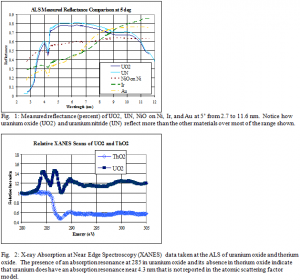Richard L. Sandberg and Dr. David D. Allred, Department of Physics and Astronomy
Recently, the extreme ultraviolet (EUV) and soft x-ray region of the electromagnetic spectrum (between about 1 and 100 nm in wavelength or 20 eV to 5 keV photon energy) has become increasingly important in technological applications. The next generation of optical technologies will include EUV astronomy, high resolution soft x-ray microscopy for medical/materials science imaging, and EUV computer lithography. These technologies all require optical devices: mirrors, lenses, and other imaging equipment. The Brigham Young University’s EUV Optics research team has been studying the properties of uranium as an EUV optical material for several years. Here I review the research I conducted at as part of my ORCA mentoring grant which has been to find and implement applications for uranium-based optics for the EUV and soft x-ray region and to understand the properties of these uranium-based thin films.
My original focus for this project was to understand the measured absorption edge shift in reflectance measurements that my group had made at the Advance Light Source (ALS) at Lawrence Berkeley National Laboratory. These samples included thorium and uranium thin-film coatings (approximately 50 nm thick) that had been sputtered onto silicon test wafers. However, as the project got underway, my advisor, I and other students (primarily Jed Johnson) realized that more detailed measurements of our samples were needed. So my project focus changed from doing a rigorous analysis of the data previously taken in order to understand the absorption shift to taking further measurements of uranium compounds and comparing those to standard EUV and soft x-ray mirror coatings (gold, iridium, and nickel), hence the different subtitle to this paper.
Creating optics (mirrors, lenses) that manipulate high energy radiation (EUV and soft x-ray light) is difficult. The behavior of light of these wavelengths as it passes through various materials is not well known. This behavior is quantified in physical laws as optical constants n and k (index of refraction and adsorption coefficient). For visible light, n and k have been tabulated for a vast array of materials. However, few materials have been examined in the EUV range and most tables that do exist are at least partially wrong. Additionally, at these short wavelengths, light interacts strongly with everything. Even air will completely absorb a EUV light beam in a few inches.
One way to study the EUV optical properties of materials is through reflectance and transmission measurements. These involve shining a bright source of EUV/soft x-ray light onto the sample at various angles to the surface and then measuring the light reflected off of the surface or transmitted through the sample. However, bright EUV/soft x-ray light is difficult to produce and control. For this reason, our measurements were taken at a synchrotron at the ALS. A synchrotron is a large powerful device that contains a spinning beam of electrons. These electrons are accelerated to extremely high velocities. These accelerating electrons produce extremely intense EUV/soft x-ray radiation. We used this light to measure the EUV/soft x-ray reflection of our samples. Our samples were prepared at BYU using evaporation or sputtering devices in a high vacuum. We used these devices to deposit thin films of metals or dielectric material onto substrates. A variety of other techniques are used to understand the surface roughness, thickness, and composition of our samples.
The major findings of my research were the measured reflectance of gold (29.5 nm thick), nickel (49.7 nm thick), iridium, uranium oxide (31.8 nm), and uranium nitride (38 nm) thin films with light from 2.7 to 11.6 nm in wavelength. These reflectances were compared at 5, 10, and 15 degrees grazing incidence. The percent reflectance verves wavelength comparison of these materials at 5 degrees grazing incidence is shown in Fig. 1. Notice how the uranium oxide (UO2) and uranium nitride (UN) samples reflect more than gold (Au), iridium (Ir), and nickel oxide on nickel (NiO on Ni) from about 4 nm to 8.5 nm with almost twice the reflectance.
Fig. 2 shows another type of measurement taken at the ALS, X-ray Absorption Near Edge Spectroscopy or XANES. This measurement technique shows where the sample has absorption resonances (i.e. at what wavelengths the sample’s atoms resonantly absorb light). These resonances appear as peaks in Fig. 2. Uranium oxide and various thorium compounds were studied to give us a greater understanding of the absorption shift noticed in previous measurements. These absorption features from the XANES spectrum and our reflectance measurements do not agree with the reflectance and absorption data predicted by existing computational models (such as the atomic scattering factor model). Due to this disagreement, we conclude that further measurements and a greater understanding of the optical properties of these materials in needed.
This research has been presented at several meetings including the following: 2004 BYU Spring Research Conference, 2004 Utah Academy of Sciences, Arts, and Letters, 2004 International Conference on Metallurgical Coatings and Thin Films in San Diego, 2004 Annual Meeting of the International Society of Optical Engineers (SPIE) in Denver. Two proceedings papers were published, one in concurrence with each of the last two meetings listed.1,2 Additionally, drafts of the paper are being prepared to submit to the Journal of Applied Optics and the Journal of Optical Engineering. Additional information may be obtained from my Senior Thesis available through the Department of Physics and Astronomy at BYU.3

References
- Richard L. Sandberg, et al. “Uranium Oxide and Uranium Nitride as Highly Reflective Coatings from 2.7 to 11.6 Nanometers,” Proceedings of the International Conference on Metallurgical Coatings and Thin-Films, 2004 (submitted to editor).
- Richard L. Sandberg, David D. Allred, Shannon Lunt, Marie K. Urry, R. Steven Turley, “Optical Properties and Application of Uranium-based Thin Films for the Extreme Ultraviolet and Soft X-ray Region”, Proceedings of SPIE, Vol 5538, pp 107-118 (2004).
- Richard L. Sandberg, “Optical Applications of Uranium Thin-Film Compounds For the Extreme Ultraviolet and Soft X-ray Region ,” (Senior Thesis) Dept. of Physics and Astronomy, Brigham Young University, 2004.
